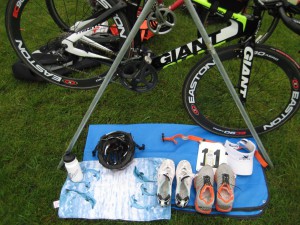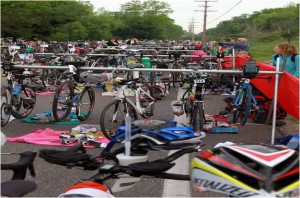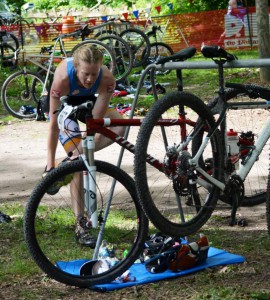By Roxane Kippen, Team OAM Now Triathlete
Hold on a minute, isn’t triathlon just three disciplines? Yes swim, bike and run take up the majority of the race, but there are these precious seconds, or for some, minutes where you have to wiggle out of your wetsuit and put on a bike helmet (T1) and change from bike shoes to run shoes (T2). While time spent in the transition area may not be long, how wisely you use that time could be the difference between being on the podium or wishing you were.
With triathlon, there are usually a few “I could have been faster if I had only: sighted better in the swim so I wasn’t weaving all over the course, or not pushed so hard on the bike so I had solid legs to run on, or pushed harder on the run so I didn’t get caught in the last 100 meters.” What people might not realize is a good transition time can often make up for small mistakes elsewhere.
I’m not the fastest swimmer in the field, but I hold my own. However, my T1 transition is quick and efficient and usually sets me in great position heading out on the bike. In fact, I can generally make up anywhere from 15 to 30 second deficit from a slower swim with a fast T1 time. My transition times are always among the fastest in the women’s field and I actually posted the fastest T1 and T2 times out of both men and women at a race last summer.
Is transition a special talent I possess? Does a fast transition matter? Transition is a skill, just like swimming, and it can be practiced and improved. Transition does matter, as I have seen many a podium spot slip out from under athletes, because they did not prepare well for their entire race. When races are decided by less than 30 second gaps, you’d better believe 30 extra seconds in transition can cost you a win. So how do you get good at it? Like any other discipline in triathlon, you need to practice. Below are some rules and tips for how to shave seconds and maybe minutes off your next race.
 Rule #1 – BE ORGANIZED
Rule #1 – BE ORGANIZED
Organization is critical to a fast transition. You don’t get a lot of room in transition. Typically, one rack will have 8 bikes, so you need to be organized and keep only what you need in the transition area. Do not leave your duffle bag or backpack in the transition area. It will get in your way and it will get in the way of other racers by creating a road block when trying to un-rack and re-rack your bike.
 Rule #2 – KNOW THE LAY OF THE LAND
Rule #2 – KNOW THE LAY OF THE LAND
I see it at every race, the athlete who doesn’t know which direction to head with his or her bike or which way to head for the run course. Every transition area is marked with Swim In, Bike Out, Bike In and Run Out signage. Pay attention to these signs and know which corner of transition you should be aiming for during each transition. Also, pay attention to where your rack is located. The swim can sometimes leave you disoriented, and unless you make note of a landmark or count the number of racks to your bike, you might find yourself wandering aimlessly about T1 trying to find your bike. Check from both directions as the bike in will look different than bike out. With rows and rows of bike racks, you don’t want to waste time locating your stuff.
Rule #3 – VISUALIZE THE TRANSITION
Imagine how you are going to execute both T1 and T2. Which side of the bike will you be on? How are you going to un-rack your bike? From which side are you going to re-rack your bike? Is that the side where your running shoes are staged? Walking through all the details of the transitions in your head a few times before heading to the swim start should put you at ease and make transition a natural flow rather than mass chaos.
Rule #4 – DON’T SPEND AS MUCH TIME GETTING OUT OF A WETSUIT AS IT SAVED YOU IN THE SWIM
My swim times with a wetsuit and without a wetsuit vary by 8 – 10 seconds per hundred meters. For a 1500 meter swim, I can be up to 2.5 minutes faster when wearing a wetsuit. If it takes me 2.5 minutes to get out of my wetsuit, I’ve done myself no favors by wearing one, except maybe to keep myself warm if the water temps are chilly. I have seen this scenario happen over and over with athletes who have a wetsuit that is difficult to take off. Please, please, please, don’t waste three minutes in transition fighting with your wetsuit. Practice taking off your wetsuit just as much as you practice swimming in the weeks leading up to a race.
 Tip #1 – DO MORE THAN ONE THING AT A TIME
Tip #1 – DO MORE THAN ONE THING AT A TIME
While I’m doing the stomp dance to get my legs out of my wetsuit, I’m grabbing my helmet and sunglasses, so once my legs are free, all I have left is to put on my shoes and bolt out of T1 with my bike. When I come in for T2, while I’m bent over from putting my helmet down, I go straight for my shoes without standing back up. Left bike shoe off, Left run shoe on, right bike shoe off, right run shoe on. As I’m running towards the Run Out sign, I’m putting on my visor and number belt. Multi-tasking in this way will save you valuable seconds.
Tip #2 – POWDER IS YOUR FRIEND, SHOE STRINGS ARE NOT
Not only does powder make your shoes smell better, but it also makes them very easy to slip on when your feet are wet and/or sweaty. I douse both my bike and run shoes with anti-friction powder. It also helps prevent blisters if you race sockless. Exchanging shoe strings, which you have to tie, for elastic laces that are preset to the right tension is a huge time saver. With the powder to help you slip your foot in and the laces already tight for you, off to the run course you go, typically faster than other racers who must take the time to do both these things.
Tip #3 – THE BOTTLE VS THE BUCKET
With respect to Rule #1, you want to minimize the junk taking up space in the transition area. Many people still bring a bucket or a tub filled with water to step in to rinse their feet before putting on their bike shoes. Honestly, unless you go straight from a swim exit on a sandy beach into T1, you likely won’t need to rinse your feet off. A run through the grass or down the sidewalk will give your feet enough time to dry out a little and for any dirt or sand to fall off. However, you definitely don’t want any debris rubbing your foot for an hour either, so if you have anything stuck on your feet, I have found the fastest remedy is to just brush it off with a towel. I do like to have an old water bottle handy next to my bike shoes just in case I do need to squirt sand off, but a dry towel usually does the trick. It takes up less space and is more efficient than stepping in and out of a tub of water.
As with any discipline, a good transition comes with practice. It’s not too late to do a little visualizing and quick shoe changing before your next event. I leave my helmet, bike shoes, and run shoes in my kitchen the week of the race and every time I enter the room, I run through the change. The more you practice, the faster you will get.
I hope this blog has provided some tips for you to post some time improvements on your next race. See you out there and good luck! I’ll be the one passing you in transition.




 Our Hockey Site
Our Hockey Site Team AM
Team AM

